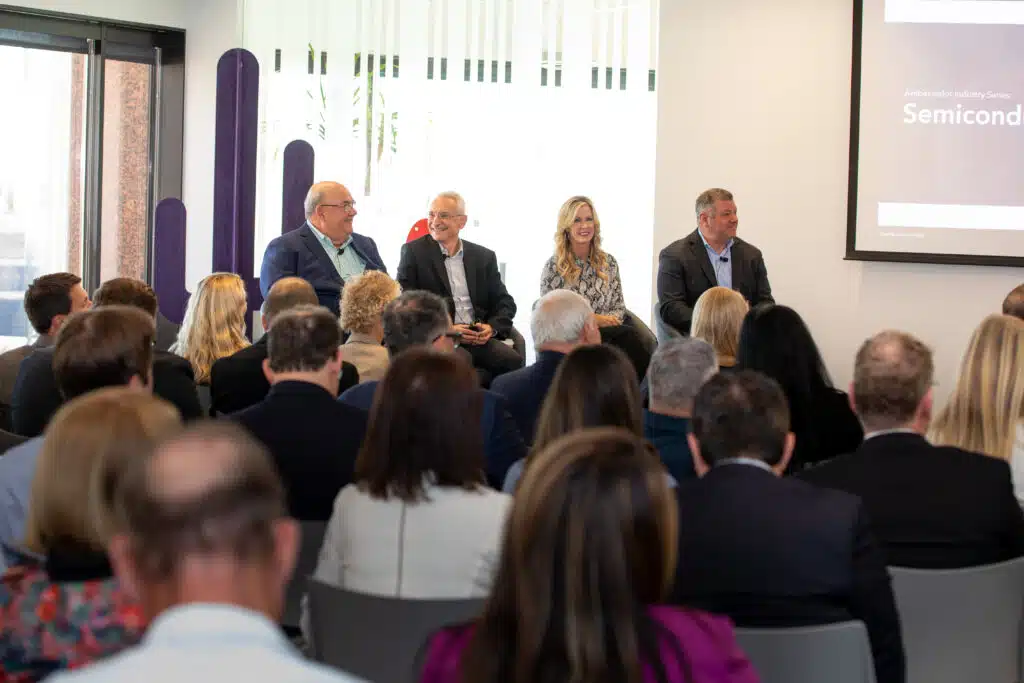
Ambassador Event: The Future of Semiconductors
Published: 04/29/2025
How semiconductor growth in Greater Phoenix will help disruptive technology scale
In 1949, Motorola opened a research lab in Greater Phoenix, setting the foundation for companies like Intel, NXP and Taiwan Semiconductor Manufacturing Company (TSMC) to later establish manufacturing facilities for semiconductor chips and other vital elements of the supply chain in the market.
Today, the region is a national hub of advanced manufacturing. The Greater Phoenix Economic Council (GPEC) looked toward the future of semiconductors in its latest research report and Ambassador Event, exploring disruptive technology, the education ecosystem, water usage and more that will contribute to the next-generation production of chips.
The panel consisted of:
- Chad Cobbley, Senior Manager, Business Development, Bechtel Corporation
- Angela Creedon, Director, State and Local Government Relations, Intel
- David McCann, Senior Vice President, Chief of Staff, Amkor Technology
- Joe Stockunas, President, SEMI Americas
- Thomas Maynard, Senior Vice President of Business Development, GPEC (Moderator)
“There’s so much energy around our industry right now. I think it’s exciting to see where we go from here,” Creedon said. “As we develop new technologies, increase our talent pipeline, diversify the thought, and diversify the innovation that’s going to come out of just the state of Arizona alone — as a native of the state, I’m excited about it and I think there’s a lot of positives and opportunities as we move forward.”
Setting the stage for future growth
Greater Phoenix is the nation’s leading metro for semiconductor supply chain investment since 2020, led by TSMC’s $165 billion for six fabs, two advanced packaging facilities and a research center in Phoenix, Intel’s $20 billion investment in 2021, Amkor’s expansion into Peoria, and more than 40 suppliers and other related companies that have announced plans to enter the market.
There are more than 33,000 direct semiconductor industry jobs in the region, and Greater Phoenix is ranked as the fourth-largest semiconductor industry workforce in the nation. These figures are bolstered by Arizona State University’s (ASU) engineering school and industry-specific programs across the state’s universities and community colleges.
The semiconductor ecosystem intersects with other emerging industries in the advanced manufacturing ecosystem, which gives Greater Phoenix an advantage as next-gen chips develop.
Read the report here.
Disruptive technology and research
A variety of industries rely on semiconductor chips. Stockunas said about half of semiconductor chips are consumed by computer and communication devices like cell phones and laptops, but market growth offers opportunities in other facets of tech.
“The implications of adding machine learning into the manufacturing base provide a very similar opportunity for growth,” he said.
The panelists touched on numerous industries being driven by semiconductors:
- Artificial intelligence: AI capability is driven by semiconductors, and rapid changes in the industry are reshaping how chips are designed, manufactured and deployed.
- Automotive and mobility: SEMI projects an increase of 12% of semiconductor chip usage over the next 10 years.
- Quantum computing: “It’s a common misnomer that quantum is going to replace classical computing, but it doesn’t work that way,” Cobbley said. “Quantum is going to complement classical computing, which will proliferate the momentum ahead.”
- Photonics: Development of photonics can increase speed of chips and lower the energy per bit, McCann said.
- Healthcare, bioscience and other medical-related fields: SEMI and the Medical Device Manufacturing Multiplier Consortium (MDM2) hosted a conference April 22-24 that explored the intersection of medical technology and semiconductors. The expansion of these industries side-by-side in Greater Phoenix offer increased opportunity for growth in drug research, pharmaceutical production, medical device manufacturing, bioscience development of other medical-related areas.
- R&D projects like the Natcast facility at ASU Research Park: “The more we can continue to focus on at R&D, the more we can explore new technologies,” Creedon said.
“(There’s an) unbelievable runway ahead of us,” Stockunas said. “The SEMI mantra is, we’re on a path to a trillion dollars [in 2030].”
The education ecosystem of Greater Phoenix
Developing the talent pipeline is a primary focus for the industry to meet the demand of companies entering the market. Part of the obstacle is not just increasing the number of employees, but educating the students on technology that did not previously exist.
Amkor, an outsourced assembly and test vendor, is the only company of its kind headquartered in the U.S. Because no other domestic company produces packaging as advanced as Amkor, students need to not only learn packaging, but a type of packaging that doesn’t yet have established curriculum.
McCann said Amkor is working with the Maricopa County Community Colleges District (MCCCD), ASU and Grand Canyon University to incorporate job requirements into the curricula of the higher education institutions. This aligns with work of industry peers like Intel and TSMC, who have partnered with MCCCD on a quick start bootcamp for semiconductor technicians.
SEMI contributes to growing the workforce in a variety of ways, including working with the National Science Foundation for talent pipeline growth and with the military to raise awareness of the industry for personnel preparing to complete their service.
Bechtel has similarly worked with the military for career awareness, and collaborates with Intel and ASU for the Construction 570 class, which offers lectures from subject matter experts on semiconductor-related construction matter including HVAC and structural processes.
Intel hires more ASU graduates for its operations than any other university.
“Our educational institutions really adapt and grow with us,” said Creedon. “One thing about Arizona is we’re quick and we respond quickly to the needs of business, and that’s been huge for our industry.”
Water and sustainability
Arizona has a long history of water management and conservation. Modern companies strive to maintain good stewardship of this vital resource.
Intel is a net-positive water user in the U.S. The company spearheaded the build of a water treatment facility in Chandler, and has funded 20 water restoration projects that benefit Arizona. At full buildout, those projects will restore almost 2.2 billion gallons annually, according to Intel.
Amkor, in Peoria, has committed to reuse 80% of the water in its process. The company is also aiming to be the first packaging and assembly facility in the world that is free from per- and polyfluoroalkyl substances (PFAS).
“The largest consumers of semiconductors are very committed to a zero-carbon footprint,” Stockunas said. “It really is something that makes sense as an industry to collaborate on. We’re not going to solve it individually.”
To foster collaboration, SEMI launched the Semiconductor Climate Consortium, which focuses on PFAS, clean energy and energy demand. Stockunas said that while there’s been good progress over the last three decades, the industry has further work to do in this tech-driven world.
“The industry has done a very good job. There’s been a strong focus on power consumption in semiconductors,” he said. “In the previous 30 years, we’ve reduced the power consumption of a semiconductor by 10,000 times. The problem is, going forward for 30 years, we need to do the same thing.”
Meet the Panel
Chad Cobbley
Senior Manager, Business Development
Bechtel Corporation
Angela Creedon
Director, State and Local Government Relations
Intel
David McCann
Senior Vice President, Chief of Staff, Business Unit
Amkor Technology
Joe Stockunas
President
SEMI Americas
Thomas Maynard (Moderator)
Senior Vice President of Business Development
Greater Phoenix Economic Council





